Complete Solutions to PROBLEMS of chapter WAVE - II of Class 12 book with complete answers and questions
| Class 12 | PHYSICS |
| Chapter | WAVE - II |
| RESNICK AND HALLIDAY | PROBLEMS |
| Number Of Questions | 59 |
| Academic Year | 2023-24 |
Diagnostic ultrasound of frequency 3.80 MHz is used to examine tumors in soft tissue. (a) What is the wavelength in air of such a sound wave? (b) If the speed of sound in tissue is 1500 m/s, what is the wavelength of this wave in tissue?
View SolutionWhat is the intensity at radial distances (a) 2.50 m and (b) 6.00 m from an isotropic point source of sound that emits energy at the rate 12.0 W, assuming no energy absorption by the surrounding air?
View SolutionWhen you "crack" a knuckle, you suddenly widen the knuckle cavity, allowing more volume for the synovial fluid inside it and causing a gas bubble suddenly to appear in the fluid. The sudden production of the bubble, called "cavitation, "produces a sound pulse - the cracking sound. Assume that the sound is transmitted uniformly in all directions and that it fully passes from the knuckle interior to the outside. If the pulse has a sound level of 50 dB at your ear, estimate the rate at which energy is produced by the cavitation.
View SolutionA tuning fork of unknown frequency makes 4.00 beats per second with a standard fork of frequency 384 Hz. The beat frequency decreases when a small piece of wax is put on a prong of the first fork. What is the frequency of this fork?
View SolutionA sound wave of frequency 280 Hz has an intensity of `1.00 W//m2` ? What is the amplitude of the air oscillations caused by this wave?
View SolutionTwo identical piano wires have a fundamental frequency of 600 Hz when kept under the same tension. What fractional increase in the tension of one wire will lead to the occurrence of 8.0 beats/s when both wires oscillate simultaneously?
View SolutionA sound source A and a reflecting surface B move directly toward each other. Relative to the air, the speed of source A is 20.0 m/s, the speed of surface B is 80.0 m/s, and the speed of sound is 329 m/s. The source emits waves at frequency 2000 Hz as measured in the source frame. In the reflector frame, what are the (a) frequency and (b) wavelength of the arriving sound waves? In the source frame, what are the (c) frequency and (d) wavelength of the sound waves reflected back to the source?
View SolutionA whistle of frequency 540 Hz moves in a circle of radius 60.0 cm at an angular speed of 20.0 rad/s. What are the (a) lowest and (b) highest frequencies heard by a listener a long distance away, at rest with respect to the center of the circle?
View SolutionThe shock wave off the cockpit of the FA 18 has an angle of about `60^@` . The airplane was traveling at about 1350 km/h when the photograph was taken. Approximately what was the speed of sound at the air plane's altitude?
View SolutionA bat is flitting about in a cave, navigating via ultrasonic bleeps. Assume that the sound emission frequency of the bat is 39 .000 Hz. During one fast swoop directly toward a flat wall surface, the bat is moving at 0.020 times the speed of sound in air. What frequency does the bat hear reflected off the wall?
View SolutionThe source of a sound wave has a power of 3.00` muW`. If it is a point source, (a) what is the intensity 4.20 m away and (b) what is the sound level in decibels at that distance?
View SolutionA sound source sends a sinusoidal sound wave of angular frequency 3000 rad/s and amplitude 10.0 nm through a tube of air. The internal radius of the tube is 2.00 cm. (a) What is the average rate at which energy (the sum of the kinetic and potential energies) is transported to the opposite end of the tube? (b) If, simultaneously, an identical wave travels along an adjacent, identical tube, what is the total average rate at which energy is transported to the opposite ends of the two tubes by the waves? If, instead, those two waves are sent along the same tube simultaneously, what is the total average rate at which they transport energy when their phase difference is (c) 0, (d) 0.40`pi` rad, and (e) `pi` rad?
View SolutionTwo atmospheric sound sources A and B emit isotropically at constant power. The sound levels `beta ` of their emissions are plotted in Fig. versus the radial distance r from the sources. The vertical axis scale is set by `beta_1 = 85.0 dB and beta_2 = 65.0 dB` . What are (a) the ratio of the larger power to the smaller power and (b) the sound level difference at r = 23 m?

View SolutionA jet plane passes over you at a height of 4800 m and a speed of Mach 1.5. (a) Find the Mach cone angle (the sound speed is 331 m/s). (b) How long after the jet passes directly overhead does the shock wave reach you?
View SolutionOrgan pipe A, with both ends open, has a fundamental frequency of 425 Hz. The fifth harmonic of organ pipe B, with one end open, has the same frequency as the second harmonic of pipe A. How long are (a) pipe A and (b) pipe B?
View SolutionA certain sound source is increased in sound level by 40.0 dB. By what multiple is (a) its intensity increased and (b) its pressure amplitude increased?
View SolutionFigure shows four tubes with lengths 1.0 m or 2.0 m, with one or two open ends as drawn. The fifth harmonic is set up in each tube, and some of the sound that escapes from them is detected by detector D, which moves directly away from the tubes. In terms of the speed of sound v, what speed must the detector have such that the detected frequency of the sound from (a) tube 1, (b) tube 2, (c) tube 3, and (d) tube 4 is equal to the tube's fundamental frequency?
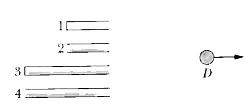
View SolutionA point source emits 30.0 W of sound isotropically. A small microphone intercepts the sound in an area of 0.750 cm?, 180 m from the source. Calculate (a) the sound intensity there and (b) the power intercepted by the microphone
View SolutionA plane flies at 2.00 times the speed of sound. Its sonic boom reaches a man on the ground 35.4 s after the plane passes directly overhead. What is the altitude of the plane? Assume the speed of sound to be 330 m/s.
View SolutionA point source emits sound waves isotropically. The intensity of the waves 6.00 m from the source is `4.50 xx 10^(-4) W//m^2` . Assuming that the energy of the waves is conserved, find the power of the source.
View SolutionA tube `1.0 m` long is closed at one end. A stretched wire is placed near the open end. The wire is `0.3 m` long and a mass of `0.01 kg` . It is held fixed at both ends and vibrates in its fundamental mode. It sets the air column in the tube into vibration at its fundamental frequency by resonance. Find
(a) the frequency of oscillation of the air column and
(b) the tension in the wire.
Speed of sound in air = `330 m//s` .
View SolutionEarthquakes generate sound waves inside Earth. Unlike a gas, Earth can experience both transverse (S) and longitudinal (P) sound waves. Typically, the speed of S waves is about 4.5 km/s, and that of P waves 8.0 km/s. A seismograph records P and S waves from an earthquake. The first P waves arrive 3.5 min before the first S waves. If the waves travel in a straight line, how far away did the earthquake occur?
View SolutionPipe A, which is 1.80 m long and open at both ends, oscillates at its third lowest harmonic frequency. It is filled with air for which the speed of sound is 343 m/s. Pipe B, which is closed at one end, oscillates at its second lowest harmonic frequency. This frequency of B happens to match the frequency of A. An x axis extends along the interior of B, with x = 0 at the closed end. (a) How many nodes are along that axis? What are the (b) smallest and (c) second smallest value of x locating those nodes? (d) What is the fundamental frequency of B?
View Solution(a) Find the speed of waves on a violin string of mass 860 mg and length 22.0 cm if the fundamental frequency is 920 Hz. (b) What is the tension in the string? For the fundamental, what is the wavelength of (c) the waves on the string and (d) the sound waves emitted by the string?
View SolutionFigure shows the output from a pressure monitor mounted at a point along the path taken by a sound wave of a single frequency traveling at 343 m/s through air with a uniform density of `1.21 kg//m^3`. The vertical axis scale is set by `Delta p = 5.0 mPa` . If the displacement function of the wave is s(.x, t) = `s_mcos(kx - omega t)` , what are (a) `s_m`(b) k, and (c) `omega `? The air is then cooled so that its density is 1.35 kg/m and the speed of a sound wave through it is 320 m/s. The sound source again emits the sound wave at the same frequency and same pressure amplitude. What now are (d)`s_m, (c ) k, and (f) omega ?`

View SolutionA violin string 15.0 cm long and fixed at both ends oscillates in its N = 1 mode. The speed of waves on the string is 280 m/s, and the speed of sound in air is 318 m/s. What are the (a) frequency and (b) wavelength of the emitted sound wave?
View SolutionFigure shows four isotropic point sources of sound that are uniformly spaced on an x axis. The sources emit sound at the same wavelength `lamda` and same amplitudes `s_m` and they emit in phase. A point P is shown on the x axis. Assume that as the sound waves travel to P, the decrease in their amplitude is negligible. What multiple of `s_m` is the amplitude of the net wave at P if distance d in the figure is `(a) lamda//4 (b) lamda//2 and (c ) lamda ` ?

View SolutionThe water level in a vertical glass tube 1.00 m long can be adjusted to any position in the tube. A tuning fork vibrating at 900 Hz is held just over the open top end of the tube, to set up a standing wave of sound in the air-filled top portion of the tube. (That airfilled top portion acts as a tube with one end closed and the other end open.) (a) For how many different positions of the water level will sound from the fork set up resonance in the tube's air-filled portion? What are the (b) least and (c ) second least water heights in the tube for resonance to occur?
View SolutionIn Fig. , a French submarine and a U.S. submarine move toward each other during maneuvers in motionless water in the North Atlantic. The French sub moves at the speed `v_v` = 48.00 km/h, and the U.S. sub at `v_(US)` = 72.00 km/h. The French sub sends out a sonar signal (sound wave in water) at `1.560 xx 10^3` Hz. Sonar waves travel at 5470 km/h. (a) What is the signal's frequency as detected by the U.S. sub? (b) What frequency is detected by the French sub in the signal reflected back to it by the U.S. sub?

View SolutionTwo sounds differ in sound level by 3.00 dB. What is the ratio of the greater intensity to the smaller intensity?
View SolutionThe A string of a violin is a little too tightly stretched. Beats at 4.50 per second are heard when the string is sounded together with a tuning fork that is oscillating accurately at concert A (440 Hz). What is the period of the violin string oscillation?
View SolutionA man strikes one end of a thin rod with a hammer. The speed of sound in the rod is 15 times the speed of sound in air. A woman, at the other end with her ear close to the rod, hears the sound of the blow twice with a 60 ms interval between, one sound comes through the rod and the other comes through the air alongside the rod. If the speed of sound in air is 343 m/s, what is the length of the rod?
View SolutionA 2000 Hz siren and a civil defense official are both at rest with respect to the ground. What frequency does the official hear if the wind is blowing at 15 m/s (a) from source to official and (b) from official to source?
View SolutionOne of the harmonic frequencies of tube A with two open ends is 400 Hz. The next-highest harmonic frequency is 480 Hz. (a) What harmonic frequency is next highest after the harmonic frequency 160 Hz? (b) What is the number of this next-highest harmonic? One of the harmonic frequencies of tube B with only one open end is 1080 Hz. The next-highest harmonic frequency is 1320 Hz. (c) What harmonic frequency is next highest after the harmonic frequency 600 Hz? (d) What is the number of this next-highest harmonic?
View SolutionA violin string 30.0 cm long with linear density 0.650 g/m is placed near a loudspeaker that is fed by an audio oscillator of variable frequency. It is found that the string is set into oscillation only at the frequencies 1040 and 1560 Hz as the frequency of the oscillator is varied over the range 600-1600 Hz. What is the tension in the string?
View SolutionA stationary motion detector sends sound waves of frequency 3.00 MHz toward a truck approaching at a speed of 61.0 m/s. What is the frequency of the waves reflected back to the detector?
View SolutionA stone is dropped into a well. The splash is heard 3.35 s later. What is the depth of the well?
View SolutionTwo trains are traveling toward each other at 35.7 m/s relative to the ground. One train is blowing a whistle at 850 Hz. (a) What frequency is heard on the other train in still air? (b) What frequency is heard on the other train if the wind is blowing at 35.7 m/s toward the whistle and away from the listener? ( c) What frequency is heard if the wind direction is reversed?
View SolutionYou have five tuning forks that oscillate at close but different resonant frequencies. What are the (a) maximum and (b) minimum number of different beat frequencies you can produce by sounding the forks two at a time, depending on how the resonant frequencies differ?
View SolutionFigure shows two point sources `S_1` and `S_2` that emit sound of wavelength `lamda` = 3.00 m. The emissions are isotropic and in phase, and the separation between the sources is d = 16.0 m. At any point P on the x axis, the wave from `S_1` and the wave from `S_2` interfere. When P is very far away `( x ~~ 0)` , what are (a) the phase difference between the arriving waves from `S_1` and `S_2` and (b) the type of interference they produce? Now move point P along the x axis toward `S_1`. (c ) Does the phase difference between the waves increase or decrease? At what distance x do the waves have a phase difference of (d) `0.50lamda,( e) 1.00lamda`, and (f) `1.50lamda`?

View SolutionAn ambulance with a siren emitting a whine at 1620 Hz overtakes and passes a cyclist pedaling a bike at 2.44 m/s. After being passed, the cyclist hears a frequency of 1590 Hz. How fast is the ambulance moving?
View SolutionWhen the door of the Chapel of the Mausoleum in Hamilton, Scotland, is slammed shut, the last echo heard by someone standing just inside the door reportedly comes 15 s later. (a) If that echo were due to a single reflection off a wall opposite the door, how far from the door is the wall? (b) If, instead, the wall is 32.0 m away, how many reflections (back and forth) occur?
View SolutionA stationary detector measures the frequency of a sound source that first moves at constant velocity directly toward the detector and then (after passing the detector) directly away from it. The emitted frequency is f. During the approach the detected frequency is `f'_(app)` and during the recession it is `f'_(rec)` If `(f_(app) - f'_(rec)) //f = 0.200,` what is the ratio v/v of the speed of the source to the speed of sound?
View SolutionFigure shows two isotropic point sources of sound, `S_1` and `S_2` The sources emit waves in phase at wavelength 0.50 m, they are separated by D = 2.20 m. If we move a sound detector along a large circle centered at the midpoint between the sources, at how many points do waves arrive at the detector (a) exactly in phase and (b) exactly out of phase?

View SolutionApproximately a third of people with normal hearing have ears that continuously emit a low-intensity sound outward through the ear canal. A person with such spontaneous otoacoustic emission is rarely aware of the sound, except perhaps in a noise-free environment, but occasionally the emission is loud enough to be heard by someone else nearby. In one observation, the sound wave had a frequency of 1200 Hz and a pressure amplitude of `2.50 xx 10^(-3)` Pa. What were (a) the displacement amplitude and (b) the intensity of the wave emitted by the ear?
View SolutionTwo loud speakers are located 3.35 m apart on an outdoor stage. A listener is 175 m from one and 19.5 m from the other. During the sound check, a signal generator drives the two speakers in phase with the same amplitude and frequency. The transmitted frequency is swept through the audible range (20 Hz to 20 kHz). (a) What is the lowest frequency `f_("min".1)` that gives minimum signal (destructive interference) at the listener's location? By what number must `f_("min".1)`be multiplied to get (b) the second lowest frequency `f_("min".2)` that gives minimum signal and (c) the third lowest frequency `f_("min".3)` that gives minimum signal? (d) What is the lowest frequency `f_(max.1)` that gives maximum signal (constructive interference) at the listener's location? By what number must `f_(max.1)` be multiplied to get (e ) the second lowest frequency `f_(max.2)` that gives maximum signal and (f) the third lowest frequency `f_(max.3)` that gives maximum signal?
View SolutionIn Fig. , two speakers separated by distance `d_1` = 2.00 m are in phase. Assume the amplitudes of the sound waves from the speakers are approximately the same at the listener's ear at distance `d_2` = 4.00 m directly in front of one speaker. Consider the full audible range for normal hearing, 20 Hz to 20 kHz. (a) What is the lowest frequency `f_("min".1)` that gives minimum signal (destructive interference) at the listener's ear? By what number must `f_("min".1)` be multiplied to get (b) the second lowest frequency `f_("min".2)` that gives signal and (c) the third lowest frequency `f_("min".3)` that givesr minimum signal? (d) What is the lowest frequency `f_(max.1)` that gives maximum signal (constructive interference) at the listener's ear? By what number must `f_(max.1)`be multiplied to get (e ) the second lowest frequency `f_(max.2)` that gives maximum signal and (f) the third lowest frequency `f_(max.3)` that gives maximum signal?
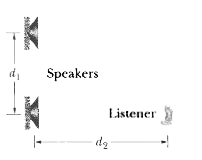
View SolutionIn Fig., sound waves A and B, both of wavelength `lamda` , are initially in phase and traveling rightward, as indicated by the two rays. Wave A is reflected from four surfaces but ends up traveling in its original direction. Wave B ends in that direction after reflecting from two surfaces. Let distance L in the figure be expressed as a multiple q of `lamda: L = q lamda`. What are the (a) smallest and (b) third smallest values of q that put A and B exactly out of phase with each other after the reflections?
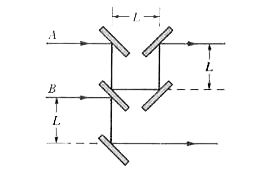
View SolutionA girl is sitting near the open window of a train that is moving at a velocity of 10.00 m/s to the east. The girl's uncle stands near the tracks and watches the train move away. The locomotive whistle emits sound at frequency 520.0 Hz. The air is still. (a) What frequency does the uncle hear? (b) What frequency does the girl hear? A wind begins to blow from the east at 10.00 m/s. ( c) What frequency does the uncle now hear? (d) What frequency does the girl now hear?
View SolutionIn Fig., S is a small loud speaker driven by an audio oscillator with a frequency that is varied from 1000 Hz to 2000 Hz, and D is a cylindrical pipe with two open ends and a length of 48.9 cm. The speed of sound in the air-filled pipe is 344 m/s. (a) At how many frequencies does the sound from the loudspeaker set up resonance in the pipe? What are the (b) lowest and (c) second lowest frequencies at which resonance occurs?
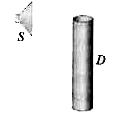
View SolutionThe pressure in a traveling sound wave is given by the equation
`Delta p = (2.00 Pa) sin pi (0.900 m^(-1) ) x - (450 s^(-1) )t ]`
Find the (a) pressure amplitude, (b) frequency, (c ) wave length, and (d) speed of the wave.
View SolutionA well with vertical sides and water at the bottom resonates at 7Hz and at no other lower frequency. The air in the well has density `1.10kgm^(-3)` and bulk modulus of water is `1.33xx10^(5)N//m^(2)`. How deep is the well ?
View SolutionA column of soldiers, marching at 100 paces per minute, keep in step with the beat of a drummer at the head of the column. The soldiers in the rear end of the column are striding forward with the left foot when the drummer is advancing with the right foot. What is the approximate length of the column?
View SolutionFrom two sources, sound waves of frequency 270 Hz are emitted in phase in the positive direction of an x axis. At a detector that is on the axis and 5.00 m from one source and 4.00 m from the other source, what is the phase difference between the waves (a) in radians and (b) as a multiple of the wavelength?
View SolutionSuppose that the sound level of a conversation is initially at an angry 75 dB and then drops to a soothing 55 dB. Assuming that the frequency of the sound is 500 Hz, determine the (a) initial and (b) final sound intensities and the ( c) initial and (d) final sound wave amplitudes.
View SolutionA sound wave in a fluid medium is reflected at a barrier so that a standing wave is formed. The distance between nodes is 4.9 cm, and the speed of propagation is 1250 m/s. Find the frequency of the sound wave.
View SolutionA train approachign a railway crossing at a speed of `120 kmh^-1` sounds a short whistle at frequency 640 Hz when it is 300 m away from the crossing. The speed of sound in air is `340 ms^-1`. What will be the frequency heard by a person standing on a road perpendicular to the track through the crossing at a distance of 400 m from the crossing ?
View Solution(a) A source of sound `S` and a detector `D` are placed at some distance from one another. A big cardboard is placed near the detector and perpendicular to the line `SD` as shown in figure. It is gradually moved away and it is found that the intensity changes from a maximum to a minimum as the board is moved through a distance of `20 cm.` Find the frequency of the sound emitted. Velocity of sound in are is `336 m//s.`
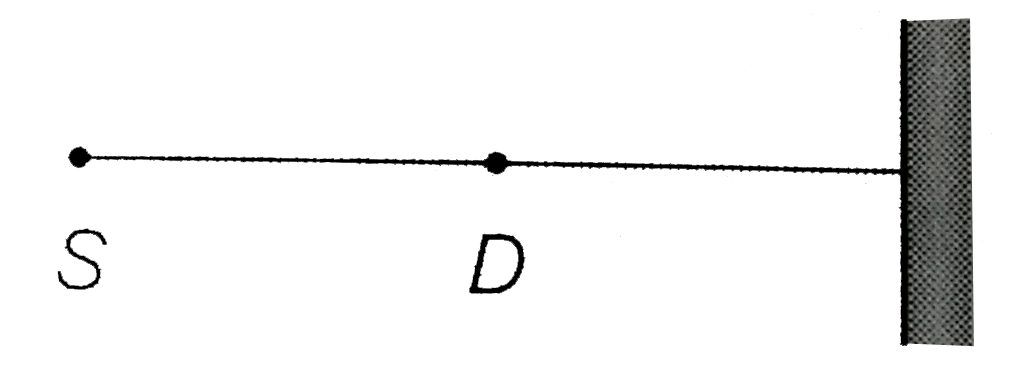
(b) A source emitting sound of frequency `180 Hz` is placed in front of a wall at a distance of `2 m` from it. A detector is also placed in front of the wall at the same distance from it. find the minimum distance between the source and the detector for which the detector detects a maximum of sound . Speed of sound in air `= 360 m//s.`
View SolutionFigure shows a source of sound moving along the X-axis at a speed of `22 m s^-1` continuously emitting a sound of frequency 2.0 kHz which travels in air at a speed of `330 in s^-1`. A listener Q stands on the Y-axis at a distance of 330 m from the origin. At t = 0, the source crosses the origin P. (a) When does the sound emitted from the source at P reach the listener Q 9 (b) What will be the frequency heard by the listener at. this instant 9 (c) Where will the source be at this instant ?
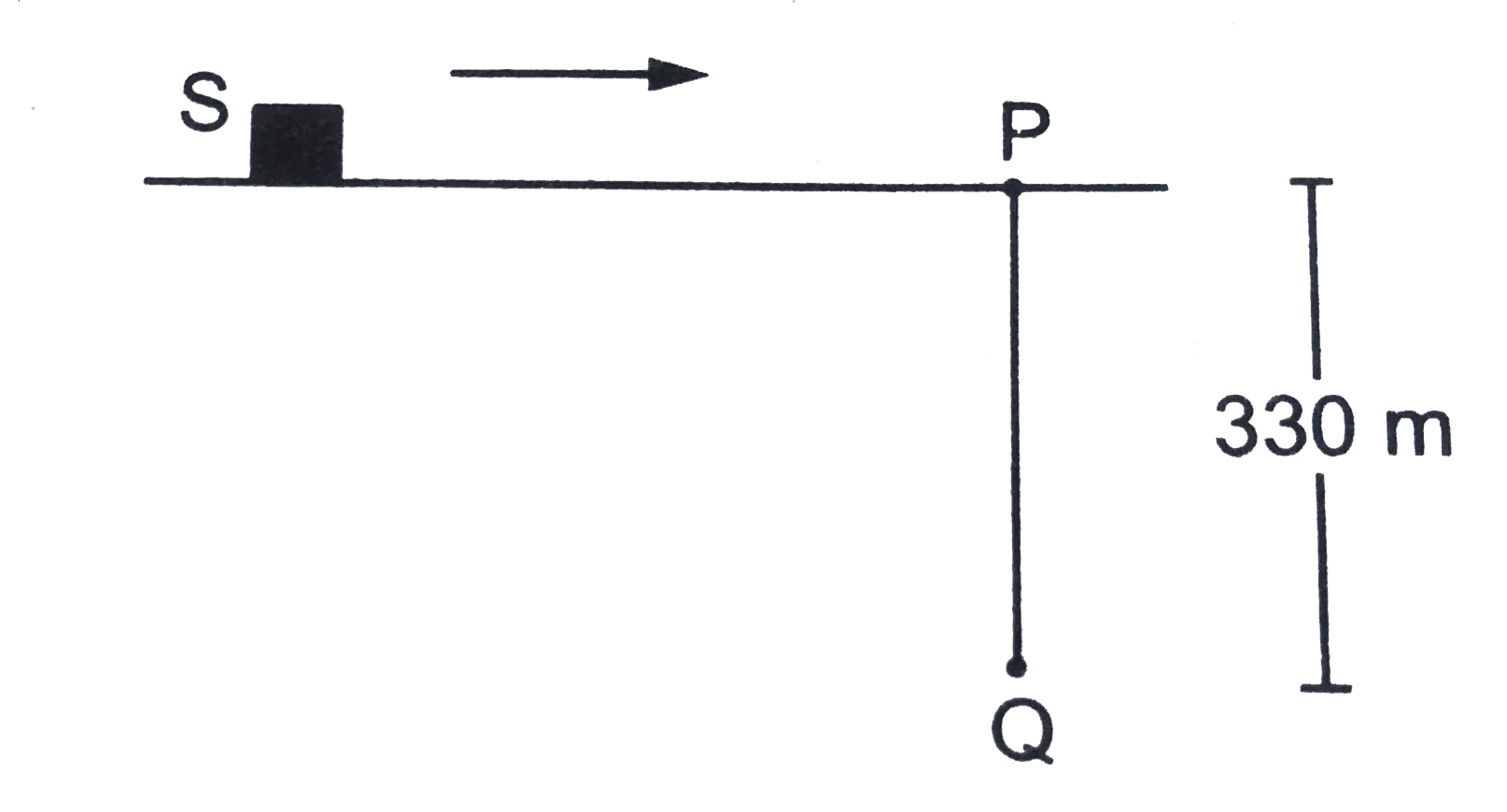 .
.
View Solution
PROBLEMS questions and complete solutions for chapter WAVE - II of RESNICK AND HALLIDAY PHYSICS (HINGLISH) of Class 12